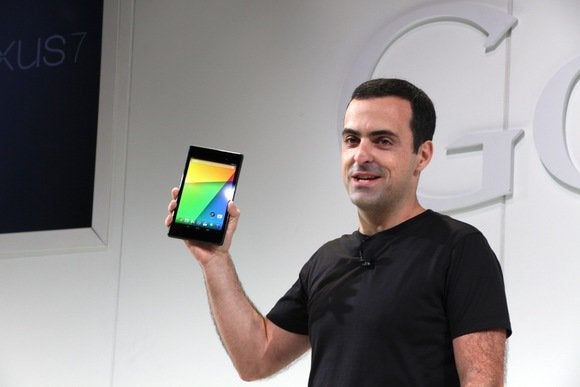Happy birthday, Android! Although you were technically announced six years ago, it wasn't until October 22, 2008 that you made your debut. Apple tried stealing your thunder this year by hosting an event or something on your special day, so we decided to hold the celebration a day early in order to keep you in the limelight. You've had an interesting five years, and it's only right that we take the time to celebrate one of the most revolutionary things to happen to mobile. Android, this is your life.
First Android phone released (October 22, 2008)
The T-Mobile G1 (known overseas as the HTC Dream) is the first smartphone to ship with Android. Even though the phone was incredibly clunky, it was pretty well received overall and sold over a million units.
 The T-Mobile G1 (HTC Dream)Google announces Cupcake (April 30, 2009)
The T-Mobile G1 (HTC Dream)Google announces Cupcake (April 30, 2009)The first major update to the OS, Android 1.5 Cupcake starts the trend of naming Android updates after desserts and adds support for widgets, video uploads to YouTube, and a virtual on-screen keyboard.
 Android fans resembled this dog when they heard the news.Android Donut unveiled (September 15, 2009)
Android fans resembled this dog when they heard the news.Android Donut unveiled (September 15, 2009)Android 1.6 Donut rolls out to the small handful of Android phones and brings with it support for more screen resolutions. The update also improves the camera and adds a speech-synthesis engine that lets Android "speak" simple lines of text.
 Homer Simpson was obviously a fan.Verizon backs Android (October 26, 2009)
Homer Simpson was obviously a fan.Verizon backs Android (October 26, 2009)The Motorola Droid is announced for Verizon, making it the first Android phone for the carrier. The phone ships running Android 2.0 Eclair, which includes a better version of Google Maps. Verizon aggressively markets the phone, painting it as the antithesis of Apple's iPhone.
The Nexus One is released (January 5, 2010)
Google decides to leave the carriers behind by releasing its own unlocked phone. The Nexus One is sold directly from Google with the promise of software updates directly from the search giant, free from any carrier or OEM interference.
 Google announces Android Froyo (May 20, 2010)
Google announces Android Froyo (May 20, 2010)Android 2.2 Froyo brings Adobe Flash to Android, allowing people to enjoy Flash videos and games on their smartphones.
 Android Gingerbread debuts (December 6, 2010)
Android Gingerbread debuts (December 6, 2010)Android 2.3 Gingerbread adds native support for NFC (near field communications) and a number of other sensors including gyroscopes and barometers. Gingerbread would go on to be the most used mobile operating system in the world.
 First real Android tablet announced (February 24, 2011)
First real Android tablet announced (February 24, 2011)The Motorola Xoom becomes the first true Android tablet and is announced alongside Android 3.0 Honeycomb. Honeycomb adds support for multicore processors and is so far the only version of Android not to go open-source.
 Bees (thankfully) not included.Malware in the Android Market (March 1, 2011)
Bees (thankfully) not included.Malware in the Android Market (March 1, 2011)The Google Play Store (known then as the Android Market) suffers from a serious bout of malware. Google ends up pulling more than 50 infected apps, and people start to seriously question how secure Android really is.
 Google shows off Ice Cream Sandwich (October 19, 2011)
Google shows off Ice Cream Sandwich (October 19, 2011)Android 4.0 Ice Cream Sandwich gives the operating system a major makeover, bringing many elements from Honeycomb to smartphones. This version of the OS includes a number of new features including Android Beam, panoramic photos, and the ability to unlock your phone using your face.
 Phablets become a thing (late October 2011)
Phablets become a thing (late October 2011)Samsung introduces the Galaxy Note, sparking a trend of smartphones with bigger screens. The phone is panned in the United States but becomes a huge success overseas, outselling many regular-size phones. Copy editors everywhere cringe as people invent a new word for this not-quite-a-phone-but-not-quite-a tablet device.
 Our poor hands.Amazon makes its own Android tablet (November 15, 2011)
Our poor hands.Amazon makes its own Android tablet (November 15, 2011)Amazon enters the Android tablet race with its Kindle Fire. The Fire runs a customized version of Android but has access only to Amazon's heavily moderated app store. The tablet's low price makes it a huge hit with consumers and the most popular Android tablet of the day.
 Google announces the Nexus 7 and Nexus Q (June 27-29, 2012)
Google announces the Nexus 7 and Nexus Q (June 27-29, 2012)At the 2012 Google I/O, the company takes the wraps off a number of products including the budget-friendly Nexus 7 and totally bizarre Nexus Q. The Q unfortunately (fortunately?) never sees the light of day, but the Nexus 7 becomes an instant hit and sells out almost immediately online.
 We're not surprised Google decided to kill this thing.Oh, and Android 4.1 Jelly Bean (June 27-29, 2012)
We're not surprised Google decided to kill this thing.Oh, and Android 4.1 Jelly Bean (June 27-29, 2012)What's a Google product launch without a new version of Android? Android 4.1 Jelly Bean adds the ever helpful Google Now and helps to unify Android tablets and phones. The update also gives the OS a much needed speed boost thanks to the improvements in "Project Butter."
 500 million Androids activated (September 11, 2012)
500 million Androids activated (September 11, 2012)Android is the most popular operating system in the world, with 1.5 million new devices activated daily.
 Nexus 10 and Android 4.2 Jelly Bean announced (November 13, 2012)
Nexus 10 and Android 4.2 Jelly Bean announced (November 13, 2012)Despite its event being canceled by a hurricane, Google goes ahead with announcing Android 4.2 Jelly Bean and the Nexus 10. This new version of Jelly Bean adds Photo Spheres and the ability to have multiple user accounts on tablets. The Nexus 10 marks the first 10-inch Nexus tablet and boasts an eye-meltingly high-resolution display.
 Andy Rubin leaves Android (March 13, 2013)
Andy Rubin leaves Android (March 13, 2013)The head of Android leaves the project to work on other things at Google. Sundar Pichai is put in charge of the department, tasked with running both the Android and Chrome teams.
 Sundar seems up to the task.New Nexus 7 and new version of Jelly Bean revealed (July 24, 2013)
Sundar seems up to the task.New Nexus 7 and new version of Jelly Bean revealed (July 24, 2013)A slimmer, faster version of the Nexus 7 is launched running Android 4.3 Jelly Bean. The update includes support for OpenGL 3.0 and Bluetooth 4.0 Low Energy.
 Armando RodriguezHugo Barra leaves Google (August 28, 2013)
Armando RodriguezHugo Barra leaves Google (August 28, 2013)In a move surrounded by scandal and mystery, the vice president of Android, Hugo Barra, leaves Google for Chinese smartphone manufacturer Xiaomi. Barra was the face of Android and was the one who stood on stage introducing the Nexus 7.
 1 billion Android devices activated total (September 3, 2013)
1 billion Android devices activated total (September 3, 2013)Android continues to grow and doesn't seem to be slowing down. It's still the most popular mobile operating system in the world and is starting to make its way into other devices like laptops, TVs, and watches.

Happy birthday, Android! Here's to another five years.
No comments:
Post a Comment